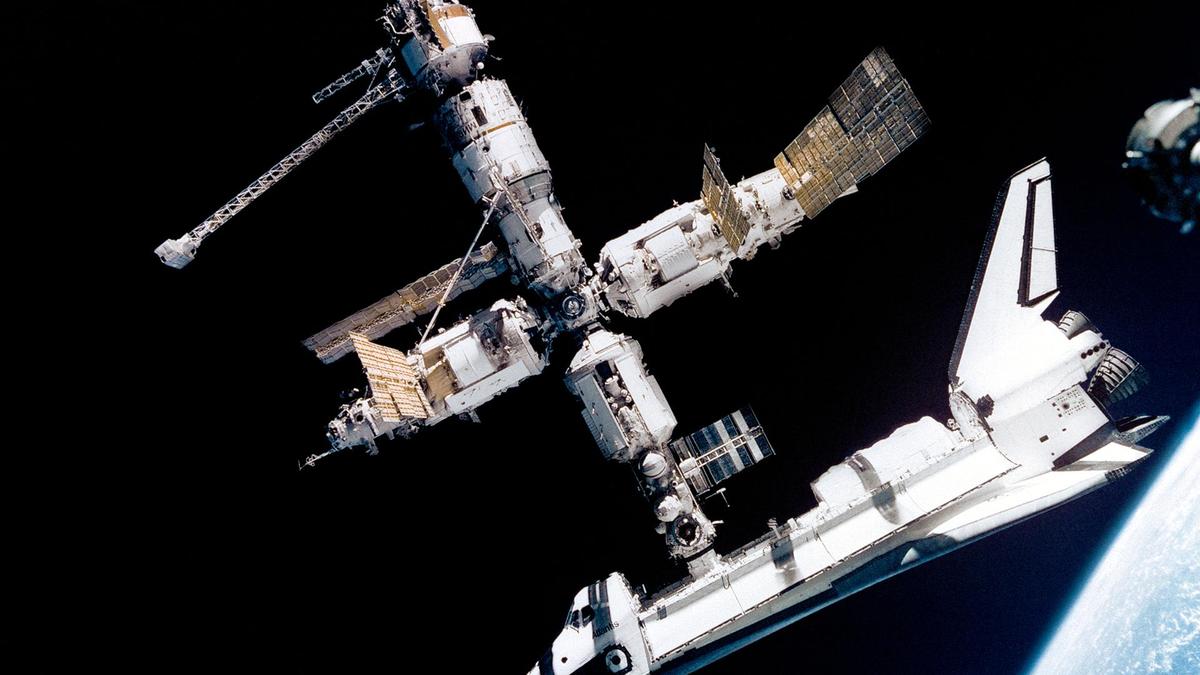A Cosmic Convergence: The Historic Docking of Atlantis and Mir in a New Era of Space Collaboration

"A Cosmic Convergence: The Historic Docking of Atlantis and Mir in a New Era of Space Collaboration"
In the annals of space exploration, few moments resonate as profoundly as the docking of the U.S. space shuttle Atlantis with the Russian space station Mir. This event, occurring less than five years after the Cold War's end, symbolized a seismic shift from rivalry to camaraderie between two former adversaries. Daniel Goldin, then NASA's chief, heralded this as the dawn of "a new era of friendship and cooperation," a sentiment that reverberated through the corridors of both nations' space agencies.
The historic STS-71 mission, which marked the 100th U.S. human space launch conducted from the Cape, was a testament to the power of collaboration. The primary objective was to achieve the first docking between the shuttle and the Russian space station, a feat that required meticulous planning and coordination. Initially slated for May 1995, the launch faced delays due to the Russian space program's activities, necessitating a series of spacewalks to reconfigure Mir for the docking.
Weather woes further postponed the launch. On June 23, inclement weather, characterized by rain and lightning, thwarted the loading of the external tank. Persistent storms and a narrow 10-minute launch window led to the cancellation of the June 24 attempt at the T-9 mark. Finally, on June 27, the skies cleared, allowing Atlantis to launch without incident.
While the launch was fraught with challenges, the docking was executed with remarkable precision. Utilizing the R-Bar or Earth radius vector approach, which leverages natural forces to brake the orbiter's approach, Atlantis closed in on Mir from directly below. This method minimized the need for orbiter jet firings, enhancing the docking's smoothness.
Commander Robert L. Gibson, tasked with the delicate maneuvering of the shuttle, guided Atlantis to within 250 feet of Mir, where stationkeeping was performed. After securing approvals from U.S. and Russian flight directors, Gibson advanced to just 30 feet from Mir, initiating the final docking phase. At a targeted speed of 0.1 feet per second, the docking was achieved with a lateral misalignment of less than an inch and an angular misalignment of less than 0.5 degrees per axis. This precise operation occurred about 216 nautical miles (400 km) above the Lake Baikal region of the Russian Federation.
Once docked, the two spacecraft formed the largest human-made object in orbit, weighing nearly 225 tonnes. The opening of hatches led to a poignant welcoming ceremony, where astronauts and cosmonauts exchanged gifts: chocolates, fruits, and flowers from Atlantis, and traditional Russian bread and salt from Mir.
The mission's scientific agenda was ambitious, with nearly 15 biomedical and scientific investigations conducted over 100 hours. These experiments spanned disciplines such as cardiovascular and pulmonary functions, human metabolism, and microgravity research. Meanwhile, the Mir 18 crew prepared for re-entry into a gravitational environment, engaging in rigorous exercises.
Samples collected from the Mir 18 crew, including blood and saliva, were transferred to Atlantis. A farewell ceremony on July 3 preceded the closing of hatches, and on July 4, the Mir 19 crew temporarily vacated the station to capture images of the separation. Commander Gibson likened this sequence to a "cosmic ballet."
The mission concluded with the crew's safe return to Kennedy Space Center on July 7, after 9 days, 19 hours, 22 minutes, and 17 seconds in space. The STS-71 mission remains a landmark in space exploration, a testament to the transformative power of collaboration and the enduring spirit of discovery.
🔮 Fortellr Predicts
Confidence: 85%
The historic docking of Atlantis and Mir continues to serve as an influential example of successful international collaboration in space exploration. In the next phase, this event's legacy is likely to inspire renewed discussions and initiatives aimed at enhancing cooperative efforts between international space agencies, particularly in light of emerging geopolitical dynamics. Stakeholders, including NASA, Roscosmos, and other international space agencies, are expected to emphasize the importance of collaboration for the upcoming Moon and Mars missions. The aerospace industry may see increased interest from private sector companies keen on participating in joint projects, given the substantial economic and technological benefits outlined by past cooperative ventures. The broader scientific community is also likely to leverage this occasion to push for increased multinational investments in space research and development. Furthermore, educational campaigns and public engagement initiatives will likely gain traction to promote awareness regarding the merits of international space partnerships.